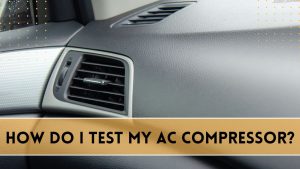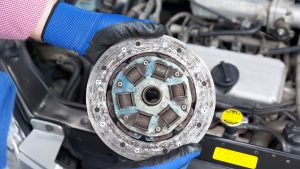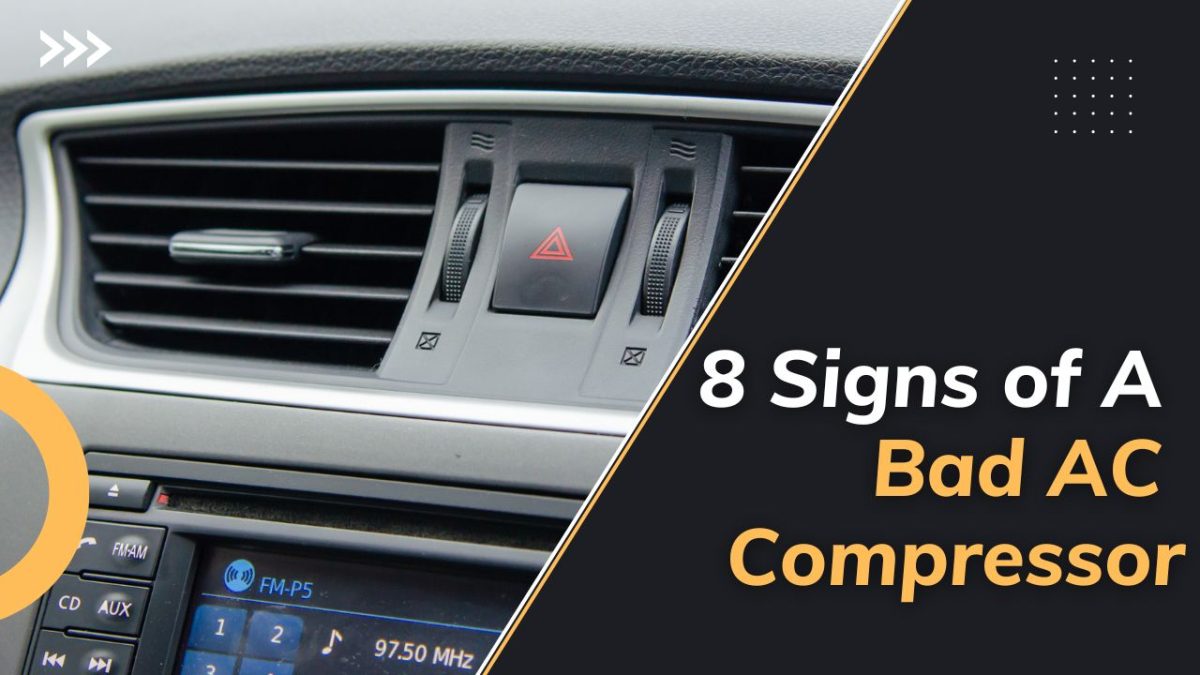January 06, 2023
8 Signs of a Bad AC Compressor
What is an AC compressor?
An air conditioning compressor is a pump that generates heat by applying very high pressure to the refrigerant used in car air conditioning systems. The reason the AC compressor is referred to as a pump is that both it and a pump can convey fluid through a pipe by increasing the pressure on the fluid. Since gases may be compressed, the compressor also reduces a gas’s volume. So, if you are having a tough time understanding your car AC’s problems, here we have discussed 8 common signs of a bad ac compressor.
If given the right care, they can endure for ten to fifteen years. Therefore, if a compressor fails, you have an emergency! In some terrible circumstances, you won’t be able to fix it and will have to replace it.
What happens when the AC compressor goes bad?
When a compressor goes bad, the air-conditioning process will not work properly as usual. Perhaps the air conditioner has become too old and is beginning to deteriorate; this could be the actual device. An engine failure could result from a malfunctioning AC compressor. Another thing you want is for the AC compressor in your car to fail and cause it to cease working. Additionally, a malfunctioning AC compressor typically impairs steering due to power limitations, which increases the likelihood of brake problems.
Whatever the cause, if you catch the compressor having issues in the early stages, you can fix them and save money on an expensive A/C compressor replacement. Finding and correcting issues early will help you save money, time, and cool air because air conditioning problems can worsen with time.
How do I test my AC compressor?
The compressor for your car’s air conditioner is a part of the engine that circulates the cool refrigerant through the HVAC system.
It primarily accomplishes this through the compressor clutch, an electromagnetic device that, in response to a signal from the PCM, activates the AC compressor pump system.
The AC compressor has to be tested to know its working condition and notice the signs of a bad AC compressor. The testing process includes a series of procedures such as
-
Check For Damages In The Ac Compressor
As you do this test, this crucial step will guard against electrocution. Along with any other switches you see nearby, turn off the power circuit for the AC compressor. Once you’re done, take off the power access panel and check the wiring connections to the air conditioner. Additionally, you should search the system for any burned terminals.
-
Visual Inspection – Verify For Burns And Other Damages
Examine it for signs of rust, physical harm, oil leaks, or paint deterioration. These are all indications that the car’s AC compressor has failed. Verify the tension on your belts and that they are in good condition. Belts that are torn or cracked might harm your AC compressor even more.
Turning off the energy circuit delivering current to your air conditioner is the first step in this physical inspection and in preventing electrical shocks and potential hazards.
The faceplate or access panel covering the conditioning unit is then unscrewed and removed, exposing its internal workings.
This is the time to look for burn marks and other physical damage on all the wires and internal components.
-
Verify the energy at the AC compressor clutch
The purpose of this initial assessment is to determine how well your compressor clutch coils are doing.
Disconnect the connector from the AC compressor clutch while setting the multimeter to read DC voltage. Connect the negative lead of your multimeter to the battery’s negative post and the positive lead of your multimeter to one of the connector terminals.
If you don’t get voltage, move your positive lead to a different terminal or, if necessary, move your negative lead to the opposite battery terminal. If you eventually detect voltage in one of these spots, your compressor clutch coil is probably to blame, and you should fix or replace it.
-
Verifying Ohms resistance
Put one multimeter probe on terminal 5 of the low switch and the second probe on terminal 7 by setting your multimeter’s dial to the Ohms (resistance) setting (depicted by the symbol ).
There is continuity if you hear a beep or see a value near 0 Ohms.
There is an open loop in its circuit and it has to be changed if you receive a reading of “O.L.”
The only difference is that you connect your multimeter leads to terminals 6 and 8 of the switch instead of the counterpart’s high-pressure counterpart. If the switch is broken, you are more likely to see an infinite Ohm value on the multimeter (1).
-
All The Pressure Switches, Check For Continuity
Before connecting a 1-meter lead to terminal five of the low-pressure switch, switch the multimeter to the ohms setting. Connect the other end to switch terminal 7. A refrigerant that is shut off and accurate is safe. However, if the pressure is dangerously low, the switch will open, which could result in inaccurate readings between the two terminals.
Signs of a Bad AC Compressor
To preserve the quality of the compressor and to ensure proper air conditioning inside the vehicle, it’s important to identify the symptoms of a bad AC compressor as soon as possible. These signs indicate that an AC compressor is in poor condition:
-
High cabin temperature
One of the initial indications of a failing AC compressor is simply that the air conditioner isn’t blowing as coldly as it did previously. The compressor’s inability to control the refrigerant flow within the element will prevent the AC from functioning properly.
A faulty compressor is undoubtedly one possibility, but other AC-related problems could make the air warmer than usual. To find out if the air temperature is higher than it should be, you can test it.
-
Moisture Leaks
If your air conditioner runs out of the chemical that turns warm air into cold air, it will continue to pump warm air. Your energy usage rises as a result of refrigerant leakage in addition to the potential for increased health risks.
Typically, compressor leaks occur at the hoses, shaft seal, and gaskets as well as O rings. Identifying these things can be challenging and may require the use of ultraviolet dyes.
-
Noise from the AC compressor
The compressor is having problems starting and is most likely to fail in the future based on these AC noises. Hammering noises indicate that the compressor’s electrical parts are failing. It might produce noise as a result of the condenser’s inside rattling. Either the compressor’s internal components have gone bad, which could produce some unpleasant noises. This is most likely the belt pulley or compressor clutch.
-
The compressor clutch will not engage

It is possible to attach and detach the pulley from the compressor’s clutch, thus allowing it to operate at any time. If the clutch malfunctions, seizes, or breaks, the compressor won’t get engine power.
The fact of the matter is that the AC clutch is a distinct device. After diagnosis, you can choose to exchange the clutch or the entire compressor unit. You can save some money and just replace the clutch because it is a separate device.
-
Broken Suction Lines
If the compressor does not function, the refrigerant line found in the AC system may become blocked, thus resulting in high-temperature airflow within the car. By sending your car to the mechanic, you can resolve this issue. If he is unsuccessful in unblocking the refrigerant lines, he will have to install new lines.
-
ECU error
The check light on your dashboard of yours is a clear indication that something more nefarious is there. The ECU monitors voltage signals going to components similar to the compressor. They may also identify signals that aren’t working properly and could supply voltage incorrectly.
-
Clogged cabin air filter
A cabin air filter filters air entering the passenger compartment before it enters the cabin. Because many drivers aren’t even aware of this maintenance item, it frequently accumulates all kinds of dirt and restricts circulation via the vent.
-
Circuit Breaker Problems
If your circuit breaker trips and you notice it, don’t keep resetting it and turning the system on. The circuit breaker is merely carrying out its duty and preventing a fire from spreading to you and your car.
Circuit breakers trip as a safety precaution to save your gadgets from an electrical overload. It occurs when there is a power spike or when you have too many gadgets running at once. The compressor trips as soon as the circuit is overloaded.
Sum Up
Therefore you should be on the lookout for the aforementioned signs of a bad ac compressor to keep your AC in good operating order. An AC compressor that fails can cause a variety of problems, such as ineffective cooling, excessive noise, reduced cooling capacity, and even electrical fires.
If you experience the signs of a failing AC compressor, you should do a car AC compressor diagnosis to rule out any other potential causes. It can be hard work and time-consuming to replace a car’s air conditioning compressor on your own. Always choose an expert auto mechanic for your car repairs and needs.

